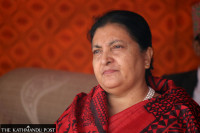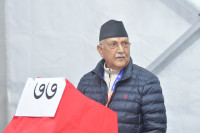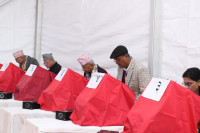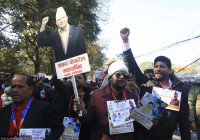Politics
Two new forces enter federal parliament as national parties
Rabi Lamichhane’s Rastriya Swatantra Party and CK Raut’s Janamat Party make the cut after the election results pour in.
Binod Ghimire
Four months ago, media personality Rabi Lamichhane-led Rastriya Swatantra Party (RSP) made a foray in Nepali politics. Registered on July 1, the party didn’t just win seven seats under the first-past-the-post elections to the House of Representatives, but also has safely crossed the threshold to qualify as a national party.
By press time on Tuesday, the party had secured over 11 percent votes under the proportional representation (PR) category to become the fourth-largest party, and was slightly behind the CPN (Maoist Centre), which has bagged 11.5 percent votes. The RSP is one of the seven parties that have qualified to become a national party. It is likely to get around 12 or 13 parliament seats under the PR category, which would take its total strength in the lower house to around 20.
Another party that has made its entry as the national party is the Janamat Party. The party is led by CK Raut and joined mainstream politics after giving up its secessionist agenda in March 2019. The Janamat Party was registered at the Election Commission in May of the same year.
It qualified as a national party in its very first attempt in the federal and provincial elections. The party that won one FPTP seat of parliament, has bagged 3.39 percent PR votes as of Tuesday evening. It is now likely to win four PR seats, taking the party’s total strength to five in the upcoming parliament.
Out of the 17.98 million registered voters in Nepal, 61 percent used their franchise rights on November 20. A party needs to win at least one FPTP seat of parliament, and based on the votes cast this time, win over 320,000 PR votes to qualify for a national party. “Over 95 percent of the votes have been counted by Tuesday evening,” Shaligram Poudel, spokesperson at the Election Commission, told the Post. “So far, seven parties, including the Janamat Party, have qualified to become national parties.”
As per the Political Parties Act, a party has to win at least one FPTP seat and three percent of the total valid PR votes cast nationwide, to earn the national party status. Similarly, a party needs to win at least three percent votes under the PR category to qualify for PR seats.
Among the 49 parties registered with the Election Commission for the proportional representation (PR) election in 2017, only five qualified to become national parties.
In the 275-strong House of Representatives, 110 members are elected under the PR category. In 2017, the 110 seats were divided only among the five parties. This time, the seats will be shared among seven parties, based on the percentage of their votes. As many as 68 parties are registered with the Election Commission to contest the PR elections.
With 35 percent vote share, the UML got 41 seats while the Congress that got 34 percent votes, managed to get 40 seats under the category. Similarly, the Maoist Centre got 17 seats, and the Rastriya Janata Party and the Sanghiya Samajbadi Forum-Nepal got six seats each. After a split in the UML, the CPN (Unified Socialist) also qualified as a national party.
Though the Unified Socialist has won 10 seats under the FPTP category, the party had secured just 2.82 percent PR votes by Tuesday evening. The party is unlikely to meet the three percent mark, if the current trend continues.
As per the existing legal provisions, a party that qualifies as a national party gets a separate office and there are benefits for the party’s parliamentary party leader and chief whip. If the party has more than 10 members, it also can appoint a whip in addition to the chief whip. Similarly, once a party qualifies as a national party, it can retain its election symbol for all other elections, which is not the case with the parties that don’t qualify to become a national party.
In addition, the qualification of the Rastriya Swatantra Party and the Janamat Party as national parties would also affect national politics, according to political experts.
They say the Rastriya Swatantra Party has already established itself as a decisive national political party, and so has the Janamat Party in Madhesh. The Rastriya Swatantra Party hasn’t hidden its intention to join the next federal government.
Tula Narayan Shah, a political analyst, said the Janamat Party has prioritised the agenda of social transformation like increasing employment and literacy rates and is very likely to join the government.
“You don’t need to be in the government to establish your political agenda. But to execute your social agenda, one has to be in the government,” Shah told the Post.
As the ruling alliance is short of a few seats for a full majority, Janamat’s entry could fill the gap.
“I see every possibility of the party joining the federal government and also the new government to be formed in Madhesh,” Shah added.




 20.12°C Kathmandu
20.12°C Kathmandu














